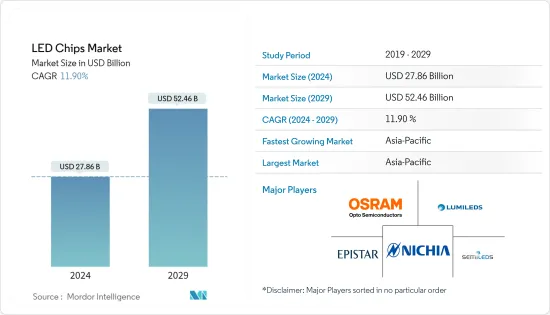PUBLISHER: Mordor Intelligence | PRODUCT CODE: 1404417

PUBLISHER: Mordor Intelligence | PRODUCT CODE: 1404417
LED Chips - Market Share Analysis, Industry Trends & Statistics, Growth Forecasts 2024 - 2029

The LED Chips Market size is estimated at USD 27.86 billion in 2024, and is expected to reach USD 52.46 billion by 2029, growing at a CAGR of 11.90% during the forecast period (2024-2029).
The increasing demand for cost, energy-efficient lighting, and various other factors drive up demand for LED chips. As a result, most developments in the LED chip market aim to provide more efficient and advanced products that offer more brightness and consume less power.
Key Highlights
- The automotive enterprise is at the forefront of LED lighting adoption, both internally and externally. OSRAM, a leading lighting manufacturer and pioneer in producing lighting for the automotive industry has supplied lighting equipment to several manufacturers. The ability to 3D print resulted in a lightweight module for automotive applications, aiding vendors. However, such applications have been limited to high-end vehicles.
- Moreover, a recent report published by LEDinside stated that Micro LED technology offers excellent performance in brightness and contrast that surpasses OLED and has a fast response time, low power consumption, and reliability, making it a perfect option for mobile and automotive applications. Considering such trends, vendors are increasing their investment in Micro LED production. For instance, in April 2023, AUO, a provider of LED solutions, announced its plans to convert its LCD 5A fab in Taiwan into a microLED production line. According to the company, the new production line is anticipated to go live by 2025 and will target applications such as wearable displays, TVs & signage displays, and automotive displays.
- The Government of India recently supported a plan to deploy low-cost LEDs nationwide among various end users. According to the Indian government, LED adoption drives annual energy savings of over 3,350 million kWh, avoiding over 6,725 MW of peak demand. Hence, such trends are anticipated to drive investment in LED chip manufacturing in the country.
- Furthermore, the other primary driver behind global LED chip growth is the advancement of LED niche lighting in fishing, healthcare, marine, horticulture, and harbor lighting. For signs and signals, LED chips are increasingly being used. These can operate on solar power or electricity and can be used to control both vehicle and pedestrian traffic at intersections. The Signs and Signal lights use LED technology with shallow power consumption values.
- Companies keep putting money into new products to increase the number of ways LEDs can be used in high-end applications. In April 2022, Ams Osram announced a USD 850 million investment to expand its LED production plant in Kulim, Malaysia. The new fab will produce LED chips and microLED chips on 8-inch wafers.
- However, a higher heat sensitivity of LED chips, which reduces their efficiency and life span, especially in industrial units and manufacturing plants, remains among the major challenging factors for the studied market's growth.
- Further, the ongoing conflict between Russia and Ukraine will significantly impact the electronics industry. The conflict has already exacerbated the semiconductor and energy supply chain issues and the chip shortage that have affected the industry for some time. The disruption may result in volatile pricing for necessary raw materials, resulting in material shortages. Furthermore, the US-China trade dispute is also anticipated to influence the studied market's growth as China is among the leading suppliers of LED chips.
LED Chips Market Trends
Automotive is Expected to Hold Major Market Share
- Vehicle manufacturing is on the rise around the world, which has a positive impact on the automotive lighting industry. The increasing production of electric automobiles heavily influences the automotive lighting market's revenue due to lower fuel costs and less harmful environmental emissions. As ambulances and police cars increasingly rely on lighting systems for signaling purposes, the demand for quality vehicle lighting solutions has increased. Furthermore, government regulations pertaining to road safety also encourage automobile manufacturers to adopt quality lighting solutions such as LEDs.
- According to the central government of China, by 2025, the country's automobile production is anticipated to reach 35 million units. With the growth in automobile production, the need for LED chips is expected to increase, which in turn is anticipated to impact the studied market's growth positively.
- Similarly, increasing global automotive production drives the demand for automotive LED chips. For instance, according to OICA, in 2022, some 85 million motor vehicles were produced worldwide. This figure translates into an expansion of around 6 percent compared with the previous year.
- Considering the growing demand, vendors are launching innovative solutions. For instance, in early 2022, Ams Osram launched the brightest LED for automotive front lighting. The Oslon Black Flat X offers 460 lumens at 1A and is available in a 1-chip and 2-chip variant. In mid-2022, the family expanded to include various multichip variants, enabling headlamp manufacturers to create cost-effective LED headlamp designs. Such developments will further drive the studied market's growth.
- LED lamps mainly consume only one-tenth of the electricity an incandescent lamp consumes. In this context, the European Union has officially recognized LED headlamps as energy-efficient. Hence, companies like OSRAM offer a broad range of LEDs for the automotive industry; for example, Audi is using OSRAM LEDs in the headlights of a new model of the Audi A8. For general lighting, OSRAM has almost all SMD LEDs from 0.1W to 5W in all dimension packages, i.e., 3030, 5050, 5630, 2835, and others.

Asia-Pacific is Expected to Witness the Highest Growth Rate
- The Asia-Pacific region has a good demand for consumer electronics and automobiles, where rapid technological changes result in high performance. As a result, the need for increased and medium-power LEDs is expected to rise. Given rising disposable income, rapid urbanization, and a shift in spending habits, the region has been the largest market for consumer electronics and is among the leading adopters of LED chips. For instance, according to IBEF, the Indian consumer electronics industry was valued at USD 9.84 billion in the previous year and is expected to more than double to INR 1.48 lakh crore (USD 21.18 billion) by 2025.
- Furthermore, the Indian government is actively introducing initiatives to move the country further along the path of transforming illumination and energy efficiency. For Instance, EESL intends to attract investments totaling INR 8,000 crores (USD 1.09 billion) under the Street Lighting National Programme (SLNP) by 2024, covering rural India. The company plans to install and retrofit approximately 30 million LED streetlights. Such investment will further drive the market's growth.
- Similarly, in November 2022, Pune Municipal Corporation (PMC) announced its plan to invest approximately INR 20 crore (USD 2.420 million) in replacing about 27,500 old public light fixtures. Such initiatives by various governments of different regions and countries across the region are expected to promote the adoption of LED lighting solutions, creating a favorable outlook for the growth of the studied market.
- Although the adoption of LED lighting solutions is on the rise, the recent US-China trade dispute has hampered the LED chip manufacturing industry in China. For instance, in January 2023, countries like the Netherlands and Japan also joined the United States in restricting the exports of semiconductor manufacturing equipment to China. However, in recent years, some of the Chinese chip manufacturing companies have been able to make positive progress in developing their chip manufacturing capabilities, which is anticipated to positively impact the studied market's growth in China during the forecast period.
LED Chips Industry Overview
The LED chips market is moderately competitive and consists of several leading players. Regarding market share, only some significant players hold a significant market presence. The manufacturers focus on product differentiation to gain a competitive advantage. The manufacturers also try to show their products superior quality to achieve higher sales. Some key market players include OSRAM Opto Semiconductors GmbH, Nichia Corporation, Lumileds Holding B.V., etc.
In July 2023, Nichia, a leading high-brightness blue and white LED producer, launched the E11A (1.1mmx1.1mm) Red, brilliant red, and green to expand its Direct Mountable Chip portfolio of high luminous flux density solutions. The company expects this expansion of the color portfolio to provide flexibility for the fixture designs and expand the application area.
In July 2023, ROHM, a leading semiconductor company, developed an RGB chip LED, SMLVN6RGBFU, ideal for automotive interiors, such as accent lighting for footwells and door handles, and function and status indicators in instrument clusters.
Additional Benefits:
- The market estimate (ME) sheet in Excel format
- 3 months of analyst support
TABLE OF CONTENTS
1 INTRODUCTION
- 1.1 Study Assumptions and Market Definition
- 1.2 Scope of the Study
2 RESEARCH METHODOLOGY
3 EXECUTIVE SUMMARY
4 MARKET INSIGHTS
- 4.1 Market Overview
- 4.2 Industry Attractiveness - Porter's Five Forces Analysis
- 4.2.1 Bargaining Power of Suppliers
- 4.2.2 Bargaining Power of Buyers
- 4.2.3 Threat of New Entrants
- 4.2.4 Threat of Substitutes
- 4.2.5 Intensity of Competitive Rivalry
- 4.3 Industry Value Chain Analysis
- 4.4 Assessment of Impact of Macroeconomic Trends on the Market
5 MARKET DYNAMICS
- 5.1 Market Drivers
- 5.1.1 Backlighting Application of Devices Boosting the LED Chips Market
- 5.1.2 R&D Investments and Government Initiatives
- 5.1.3 Power Efficiency of LED Chips
- 5.2 Market Challenges
- 5.2.1 Growing Adoption of OLEDs in Consumer Electronics
6 MARKET SEGMENTATION
- 6.1 By Application
- 6.1.1 Backlighting
- 6.1.2 Illumination
- 6.1.3 Automotive
- 6.1.4 Signs and Signals
- 6.1.5 Other Applications
- 6.2 By Geography
- 6.2.1 North America
- 6.2.2 Europe
- 6.2.3 Asia-Pacific
- 6.2.4 Latin America
- 6.2.5 Middle East and Africa
7 COMPETITIVE LANDSCAPE
- 7.1 Company Profiles
- 7.1.1 OSRAM Opto Semiconductors GmbH
- 7.1.2 Nichia Corporation
- 7.1.3 Lumileds Holding B.V.
- 7.1.4 Epistar Corporation
- 7.1.5 SemiLEDS
- 7.1.6 Bridgelux Inc.
- 7.1.7 TOYODA GOSEI Co.
- 7.1.8 Seoul Viosys Co. Ltd
- 7.1.9 Samsung Electronics. Co. Ltd
- 7.1.10 Cree Inc.
- 7.1.11 Formosa Epitaxy
8 INVESTMENT ANALYSIS
9 FUTURE OF THE MARKET




